New Products & Services
March 2011
PCMS and Track, two cost-control software packages used in petroleum refining, chemical and petrochemical industries, have joined forces. Management Controls, Inc., the owner of Track, has acquired PCMS (Project Control Management System). Users will soon benefit from contractor administration and cost control provided by Track, along with the activity-based cost tracking and forecasting that PCMS provides, all in one software package. Later this year, PCMS will become Track’s Project Cost Forecasting (PCF) module. Cost control and predictability will be improved in the execution of large projects with the use of this single software program. By giving users the ability to perform paperless contractor administration and total cost functions, and to allow them to track project costs as they occur and forecast costs at completion will create new efficiencies and ensure project success. — The Turnaround Management Company, Houston, Tex.
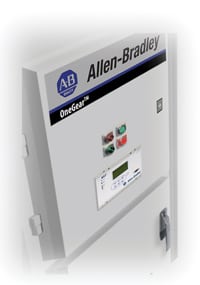
This firm has released the Allen-Bradley OneGear product line (photo) providing a full range of motor control center and power control center options. The OneGear product line is the next generation of medium-voltage motor control specifically designed for use with full voltage and solid-state, reduced voltage applications, supporting operating voltages up to 15 kV and utilizing both vacuum-contactor and circuit-breaker switching technology. All OneGear products will be available with optional arc-resistant cabinets, which meet IEEE C37.20.7 and IEC Type 2 protection. The OneGear product line offers remote monitoring, diagnostic capability and in-depth motor protection for maximum motor utilization while avoiding damage and downtime. — Rockwell Automation, Milwaukee, Wis.
Rockwell Automation
A recently introduced technology for manufacturing tantalum surface alloys offers an affordable solution for processes involving hot acids and other highly corrosive materials. The corrosion-resistant alloy can be applied to valves, fittings, instrumentation and other custom products. The process of making the alloy involves heating and reacting pure tantalum metal to produce a gaseous atmosphere of the element. The tantalum vapor creates an alloy bond with the instrument’s surface that gives corrosion-resistant properties of tantalum while maintaining the original part’s size and shape. Booth 759 — Tantaline Inc., Waltham, Mass.
http://www.tantaline.com
Scott Jenkins
The MegaMethanol and MTP (methanol-to-propylene) concepts open new routes for coal monetization, and SNG (substitute natural gas) is a possible way to convert coal into a transportable fuel — methane. SNG can be used either for power generation or routed to pipelines as an admixture to natural gas. This company is also active in the field of synthesis gas (syngas), hydrogen generation and clean conversion technologies for the production of motor fuels and chemicals. The firm is a leading technology company operating worldwide in the fields of process engineering and plant contracting. Its technology is based on proprietary and exclusively licensed technologies in the areas of gas-to-petrochemicals products via syngas or methanol or synthetic fuels, petrochemicals, petroleum-refining technology, polymers, as well as renewable resources and food. Hall 5P — Lurgi GmbH, Frankfurt, Germany
www.lurgi.com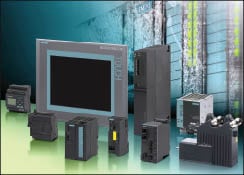
This firm has expanded the range of its Siplus extreme control and communication products (photo), which are especially suited to harsh environmental conditions. The devices are now also certified for use in toxic atmospheres (according to ISA-S71.04 GX), for offshore deployment (salt mist) and in “Arizona dust.” The components were previously suited for corrosive atmospheres (ISA-S71.04 G1, G2 and G3) as well as in situations involving 100% humidity, dewing and ice formation. — Siemens Industry Sector, Automation Div., Nueremberg, Germany
www.siemens.comA new service, called SNAP (Special Needs And Products), provides customers with customized solutions to meet unusual signal interface needs in industrial process control, system integration and factory automation applications. The SNAP service aims to fill the hole when it comes to updating instruments, replacing instruments and supplying a signal interface when an off-the-shelf instrument is not available. Typical modifications include special instrument functions, such as non-standard signal I/Os, non-standard power ranges, computing and math functions, alarm-trip modifications and so on. SNAP engineers will also work with customers to develop special and OEM instrument housings and enclosures, custom mounts and connectors and special temperature sensors and thermowells. — Moore Industries-International, Inc., North Hills, Calif.
www.miinet.com/SNAP
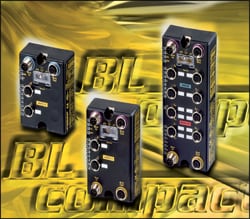 |
| Hans Turck |
This new series of compact I/O modules (photo) uses technology based on the reliable BL67 modular I/O system, and includes different BL67 electronic components and a programmable gateway within a single epoxy-sealed housing that is resistant to dirt and shock. Up to 16 digital or analog signals on one single I/O block module provide increased application compatibility and enable the user to move towards a consistently decentralized process. The IP67 stations will be available in three housing sizes and six different I/O profiles for Profibus-DP and DeviceNet. The BL compact series will soon also support all established fieldbus protocols as well as Industrial Ethernet and IO-Link. — Hans Turck GmbH & Co. KG, Muelheim an der Ruhr, Germany
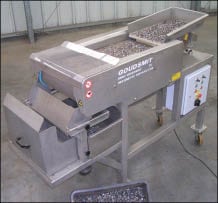
The redesigned High Gradient Separator (photo, p. 32I-7) has been developed for the recycling industry and is particularly suitable for operation in a difficult and dirty environment. The magnetic strength of the coils has been increased to 10,000 Gauss, which allows the magnetically weak iron and slightly magnetized particles to be removed from waste and residual streams. The complete system consists of a frame, a vibrating chute, a control unit, the separator and an easily adjustable splitter unit. — Goudsmitt Magnetic Systems B.V., Waalre, Netherlands
www.goudsmit-magnetics.nlThe Advanced Flow LF glass reactor is a highly flexible, low-flow glass reactor that enables a cost-effective transition to higher-volume, continuous-flow chemical processing. Like others in the product line, it continuously and efficiently streams reactants together with integrated heat exchange, but it is designed for a size suited to smaller process development. Highly engineered, glass fluidic modules form the basis of the reactor, providing mixing and heat exchange not possible in batch reactors used today. — Corning Inc., Corning, N.Y.
www.corning.com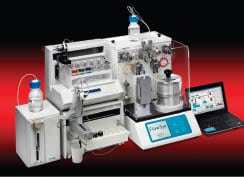
Auto-LF is an automated loop-filling module that allows flow chemists to perform multiple experiments with multiple reagents automatically. Used with for this firm’s FlowSyn range of continuous flow reactors (photo), Auto-LF enables chemists to deliver more compounds even faster. Used to prepare combinatorial libraries in Flow, FlowSyn can also perform automated experiment optimization and reagent screening. By using a separate liquid handler and fraction collector, Auto-LF allows sample loop filling for the next experiment to occur before the current experiment has finished, thereby reducing overall runtimes. — Uniqsis Ltd., Cambridge, U.K.
www.uniqsis.comBecause of the high precision offered, laser-labeling systems are increasingly replacing traditional techniques, such as printing or stamping, according to this firm. The DPLSmart Marker has been recently introduced at a price affordable to small- and medium-sized enterprises. Everything required to operate the diode-pumped, solid-state laser is integrated into a single housing. The self-contained, easily integrated module can be operated by PC via a USB interface. Special software features, such as the ability to apply barcode or data-matrix code, a rotary module integrated into the workstation, and the ability to vary the size of the labeling fields, are available to complement the system. — ACI Laser GmbH, Nohra, Austria
www.aci-laser.de
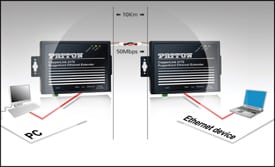 |
| Amplicon |
This firm has added a new range of Ethernet Extenders (photo), which uses DSL technology to extend communications links up to 10 km over a single pair of copper wires. The units can operate transparently as part of an existing network with no drivers to install or complex setup procedures. All IP traffic that could be sent across a standard patch cable can be sent across an Ethernet Extender link. The extenders can be used to connect two existing LANs or to connect two isolated Ethernet devices together — one of which is typically a PC running application software. — Amplicon, Brighton, U.K.
The Silver Series of touchscreen operator interface terminals (OITs) is designed for equipment manufacturers and end users that want to provide an integrated, customized interface for their equipment. Two models are offered — 7- and 10-in.-diagonal display sizes (photo) — that support a full set of features, including serial and Ethernet communication with multiple controllers; more than 30 drivers for communicating with devices; USB; SD Card; data logging; and flexible password security and multi-language support. — Watlow GmbH, Kronau, Germany
http://www.watlow.com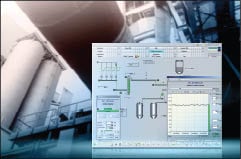 |
|
Siemens Industry Sector
|
This firm’s Industry Automation Div. has equipped Version 7.1 of its Cemat process control system (photo) with multiple new functions. An enhanced signaling and diagnostics concept is designed to reduce plant downtime as well as operating and maintenance costs, thus increasing plant availability and productivity. For example, Alarm Control is a freely-configurable signaling system integrated into the operator system for effective message display and processing. Interrupts can be individually filtered, or they can be exported for better analysis of critical plant states. Other new functions include the listing of by-passed process signals and the display of corresponding groups and routes for all process objects and object-granular alarm acknowledgement. — Siemens Industry Sector, Nuremberg, Germany
www.siemens.com/cematThe RC1e Process Safety Workstation is a semi-automated system that, in combination with iC Safety software, can be used to investigate thermal and hazardous risk of a wide range of chemical processes. Enhanced reaction control reduces the risk of large-scale failures that endanger lives, equipment and profits. A precision thermostat instantly determines all critical process parameters. The RC1e provides quality data on both desired outcomes and undesired reactive potential to identify and mitigate thermal risk. By collecting realtime heat-flow data and recording a chemical’s reactivity potential, runaway reactions are anticipated and can be avoided through appropriate process development and safety measures. — Mettler Toledo, Schwerzenbach, Switzerland
www.mt.comThe Parallel Fixed-bed (FB) Reactor is a high-throughput system capable of screening and optimizing catalysts and processes. It can be used in a variety of traditional applications within the petrochemical and petroleum-refining sectors, as well as emerging areas, such as biofuels and biorenewable processes. The system can be delivered as a stand-alone Tool (with 16, 32 or 48 reactor channels), or as part of a Tools Integrated Workflow., both available from the company. The firm can also perform experiments for targeted catalysts and process optimization problems on behalf of customers. — Symyx Technologies, Inc., Santa Clara, Calif.
www.symyx.com
The newest version of the x-purge is designed to achieve hazardous area requirements for general-purpose enclosures and their internal electronics. The unit does so by continuously purging the enclosure with compressed air or nitrogen. The positive pressure in the enclosure ensures gas flow from inside to outside and eliminates the possibility of flammable gases re-entering the enclosure. The unit is constructed from stainless steel, which offers the benefits of strength and corrosion resistance. The x-purge is certified under NFPA Class 1, Div. 1., and another version, the z-purge, is certified under NFPA Class 1, Div. 2. — Eclipse Technologies, Inc., Houston, Tex.
The Atlas Parallel Systems — multi-position reactor stations for up to eight jacketed reactors or round-bottomed flasks — offer full, independent control and logging of all reaction parameters. Controlled from a single PC, temperature, pH, stirrer speed, dosing, heat flow and turbidity can all be monitored simultaneously, making the system suitable for process optimization. A number of systems are available, including the Lithium, which automates heating/cooling in round-bottomed flasks or vials with magnetic stirrers; the Sodium, for overhead stirring and temperature control; and the Potassium, for jacketed reactions from 50 mL to 5 L. — Syrris Ltd., Royston, U.K.
Deflexion technology is a performance textile and impact-absorbing material that is designed to protect without the added bulk and stiffness of traditional padding. The impact-protection technology is based on silicones and is suitable for a wide range of products, including apparel, luggage, footwear, equipment and medical devices. — Dow Corning Corp., Midland, Mich.
The new CIL-9100R range of peelable labels provides excellent initial tack, yet can be cleanly removed without leaving any adhesive residue. These labels can withstand autoclaving, extreme temperatures (–196 to 388°C), cryostorage, chemicals and solvents. Sample and specimen variable data can be added on demand using an existing PC and laser or thermal-transfer printer. — Computer Imprintable Label Systems Ltd., Worthing, U.K.
www.cil-international.comOn October 14 – 16, Houston’s Reliant Center again plays host to the annual expo of the Instrumentation, Systems and Automation Society (ISA; Research Triangle Park, N.C.). Over 400 exhibitors will be featured at the ISA Expo 2008, North America’s largest automation and control exhibition, alongside instructor-led training sessions and other popular returning events: the ISA’s Certifïcation Quiz & Conquer, which allows ISA Certifïcation Automation Professionals (CAPs) and Certifïed Control Systems Technicians (CCSTs) to showcase their knowledge competitively; YAPFEST 2008, an exhibition for young automation professionals; and seven individual technology exchanges covering, respectively, security, wireless and networking, process automation, safety, environmental and quality control, and enterprise integration.
Long a highlight of the ISA Expo, this year’s daily keynote addresses are particularly noteworthy. Drawing on his decade-long Smart Dust research, U.C. Berkeley’s Kris Peter (Berkeley, Calif.) kick starts the series with a speech on the evolution of wireless sensor networking. Initiated with the goal of demonstrating that a comprehensive sensor and communication unit could be fabricated to fit within a single cubic millimeter, the Smart Dust project promises to be a game-changing technology. Historical in perspective, Peter’s talk will begin with the pioneering Microelectromechanical System (MEMS) research he conducted for the U.S. military charting key milestones up to and including today’s first wave of industry-standard, wireless-sensor products. On Wednesday, David J. Nagel of George Washington University (Washington D.C.) will give a presentation on instrumentation for low energy nuclear reactions, discussing the need for multiple, sophisticated sensors and automated control for the recently vindicated science of cold fusion. On the final day of the Expo, John Lienhard — national public radio host and M.D. Anderson Professor Emeritus of mechanical engineering and history at the University of Houston (Houston, Tex.) — will present a deep history of feedback control or "How we learned to think negatively in 300 BC."
More information on ISA Expo 2008 is available at www.isa.org/expo. Below is a sampling of the products and services that will be on display.
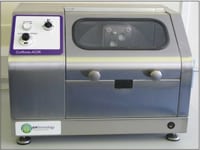 The Coflore ACR is a new type of flow reactor for use in laboratories and pilot plants. The use of multiple reaction cells and dynamic mixing gives the reactor much greater flexibility and ability to handle problem fluids. Free-floating agitator elements eliminate the need for mechanical seals and rotating shafts. The reactor has a flexible throughput (10–5,000 mL/h) and has a very low pressure drop. It is able to handle problem fluids (slurries, high viscosity fluids, slow reactions). All wetted surfaces can be assessed for cleaning, and dismantling and assembly takes less than 10 minutes. The ACR is intended for small-scale production, process development and scale up studies. Hall 6.2, Stand F21 — AM Technology, Runcorn, U.K.
The Coflore ACR is a new type of flow reactor for use in laboratories and pilot plants. The use of multiple reaction cells and dynamic mixing gives the reactor much greater flexibility and ability to handle problem fluids. Free-floating agitator elements eliminate the need for mechanical seals and rotating shafts. The reactor has a flexible throughput (10–5,000 mL/h) and has a very low pressure drop. It is able to handle problem fluids (slurries, high viscosity fluids, slow reactions). All wetted surfaces can be assessed for cleaning, and dismantling and assembly takes less than 10 minutes. The ACR is intended for small-scale production, process development and scale up studies. Hall 6.2, Stand F21 — AM Technology, Runcorn, U.K.www.amtechuk.com
The new CIL 91000 range of Self-Laminating Labels have been developed to survive cryogenic storage. The labels incorporate a clear wrap-around tail to permanently protect your computer-printed variable data, providing clear and reliable identification. These labels are suitable for vials and tubes, are waterproof and can withstand multiple freeze-thaw cycles, water-baths, solvents, abrasion and long-term storage in liquid nitrogen and ultra-low temperature freezers — even down to –196°C — without detaching, cracking or fading. Labels can be printed using a PC and laser or thermal-transfer printer. — Computer Imprintable Label Systems Ltd., Worthing, U.K.
www.cils-international.comThe newly developed overbelt electromagnets are suitable for dusty, explosion-sensitive environments in ATEX 22 zones. These magnets are suitable for removing iron particles from recycling or bulk-handling material flows, such as wood, garbage, refuse-derived fuel (RDF), hard coal and cement. The conveyor belts are durable, so they easily capture separated iron particles and cast them off. An auxiliary magnet ensures removal of the iron from the magnetic field. An optional heat exchanger with fan can be added to control the cooling of the magnet. — Goudsmit Magnetic Systems BV, Waalre, the Netherlands
www.goudsmit-magnetics.nl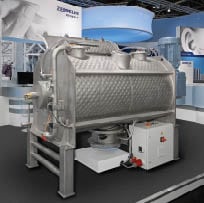
The Horizontal Cooler EFF (photo) delivers efficient cooling due to a newly designed vessel system and a newly developed, cooled mixing tool with large surface area. The Thermplate mixing vessel consists of a double-wall plate system that is appropriate for the heat transfer. Laser welding and a subsequent process of forming and inflating are used for manufacturing the mixing vessel. Water, steam and hot oils can be used as media. The vessel is made of stainless steel and rated for pressures up to 10 bars. Three cooling cycles are located inside the vessel itself, in its side walls, and in the helical mixing tool. The shape of the mixing tool is designed for increased efficiency. — Zeppelin Systems GmbH, Friedrichshafen, Germany
www.zeppelin-systems.comA new series of modular panels designed for use with ultra-high purity instrumentation or process gas-control systems is now available. The Series 53 and Series 54 are designed to provide final pressure control in gas distribution systems. The panels can be configured with one to four regulators mounted on modular 308 stainless-steel panels. Users can select from five different delivery pressures for each regulator station, from 0 – 15 up to 0 – 500 psig. — Booth 2356 — Concoa, Virginia Beach, Va.
Covered by a number of patents, the stretch hood method (photo) combines the advantages of shrink wrap and stretch wrap while avoiding the disadvantages of these traditional packaging methods. With the so-called biaxial stretch, the vertical expansion of the foil during the stretch procedure is expanded vertically by more than 5%. The residual expansion that results from this ensures that vertical tensions remain in the foil that have a decisive effect on transport safety, while also reducing consumption of packaging material. With biaxial stretch, excellent stacking stability persists, even after repeated transloading. With the unstretch technique, this firm ensures a weatherproof and shipment-safe loading unit. Hall 3.0, Stand L20 – L21 — Beumer Maschinenfabrik GmbH & Co. KG, Beckum, Germany
Ecocyl OSQ is a refillable cylinder for portable calibration and testing of highly sensitive, environmental monitoring devices. It uses a unique, negative-pressure technology that guarantees precision in the calibration-gas delivery requirements for ultra-sensitive instruments, which can be susceptible to damage from the positive gas pressure usually applied by other gas cylinders. Such instruments include detection monitors with integrated pumps or those monitors calibrated in docking stations with built-in pumping devices. These cylinders have integrated valve, pressure regulator and flow control, which are permanently protected by a protective cowling, reducing the risk associated with connecting hoses. — Linde Gases, a div. of The Linde Group, Munich, Germany
http://www.linde.com
With dewatering belts made of polyester or polyphenylene sulfide, considerably dryer sludges can be attained in serial dryers. These synthetic meshes cover working temperatures ranging from 80 to 200°C and pH values of 1–14. The belts, woven from robust monofilaments and given extensive subsequent treatment, can stand extremely high surface loads. Their specific structure also ensures excellent cleaning of the belt. The patent-pending GKD-PAD seam further develops the conventional hook seam, thereby providing operators with a considerably thinner seam than the previous glue-compressed seam while maintaining the high quality standards. The hook seam, which is covered by a textile pad, is melted and pressed together with glue into the mesh using a novel heating press. The seam is not only easy to use but also particularly durable and persistent. The GKD-PAD seam has proved its worth in various applications, especially in the sewage sludge dewatering and the fruit juice industry running on twin-wire belt presses. — GKD – Gebr. Kufferath AG, Dürren, Germany
www.gkd.de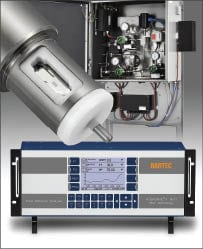
By measuring the hydrocarbon (HC) dew point and the moisture in natural gas, the Hygrophil HCDT (photo) monitors the quality of the gas while reliably protecting the plant. The measuring system consists of the display unit Hydrophil F 5673, the moisture sensor L 1660 and the HCDT sensor. Both sensors are installed in a sample system that enables precise, drift-free and fast detection of the HC and water dew point. The precision of the HCDT sensor is ±0.5°C. Measured drift can be excluded because platinum temperature sensors are considered to be drift-free and moving, easy-to-wear-out components have been integrated. As a result, the sensors do not require a cyclic recalibration. — Bartec GmbH, Gotteszell, Germany